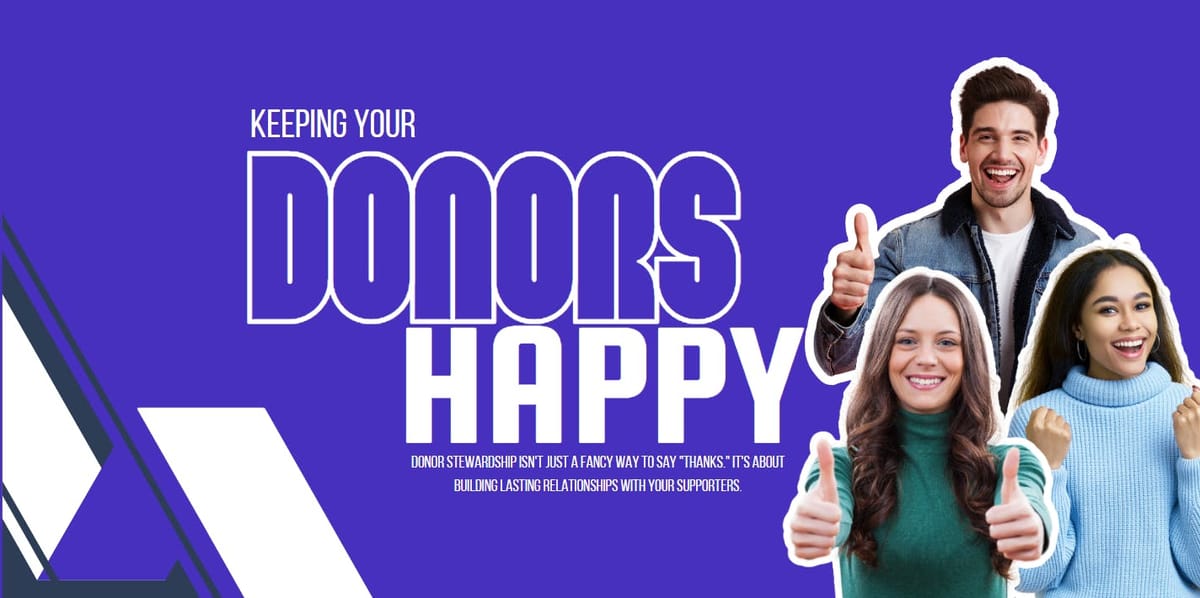Donor Stewardship on a Budget: Cost-Effective Strategies for Small Nonprofits
Discover cost-effective donor stewardship strategies for small nonprofits to enhance donor engagement and retention without a big budget.

Small nonprofits can keep donors engaged without breaking the bank. Here's how:
- Thank donors quickly and personally
- Show impact with stories and updates
- Use free tools like email and social media
- Tap into volunteer power for stewardship tasks
- Track key metrics with simple spreadsheets
Effective donor stewardship leads to:
- Higher retention rates (above the average 45%)
- More regular donations
- Long-term supporter relationships
You don't need a big budget. Focus on personal touches and consistent communication.
| Strategy | Cost | Impact |
|---|---|---|
| Handwritten notes | Low | High |
| Email updates | Free | Medium |
| Social media engagement | Free | Medium |
| Small donor events | Low-Medium | High |
| Impact stories | Free | High |
Remember: It's cheaper to keep current donors than find new ones. Invest time in stewardship now for long-term fundraising success.
Related video from YouTube
What is Donor Stewardship?
Donor stewardship isn't just a fancy way to say "thanks." It's about building lasting relationships with your supporters.
Here's what good stewardship looks like:
- Say thanks FAST (within 48 hours)
- Keep donors in the loop
- Make it personal
- Show them their impact
- Get them involved
Many small nonprofits think you need deep pockets for good stewardship. Not true!
- A handwritten note beats a glossy brochure
- Use free tools like email and social media
- Tap into your volunteer power
| Myth | Truth |
|---|---|
| Expensive materials required | Personal touch matters more |
| Only big donors deserve attention | Every gift counts |
| One-and-done approach | It's an ongoing relationship |
Bottom line: Make donors feel like the VIPs they are. It's about connection, not cash.
"Donors are your partners in the journey to your vision of a preferred future." - P.A. Robinson, Author
Check Your Current Work
Let's take a hard look at your donor stewardship. We'll see what's working and where you can do better without spending a ton.
Look at What You're Doing
Grab a pen. Write down ALL the ways you thank and engage donors. Everything from emails to big reports.
Now, ask yourself:
- How fast do we say thanks?
- Do our messages feel personal?
- Are we showing donors their impact?
Be brutally honest. We're not here to feel good, we're here to get better.
Find Ways to Get Better
Got your list? Good. Now let's find cheap ways to level up.
Quick Wins:
- Speed up: Thank donors in 48 hours or less. It's free and it works.
- Get personal: Use names in emails. Takes seconds, feels special.
- Tell stories: Show how donations help real people. Costs nothing.
Dig Deeper:
Make a simple "stewardship matrix" to spot gaps:
| Donor Level | Thank You | Updates | Recognition |
|---|---|---|---|
| Under $100 | None | None | |
| $100-$500 | Letter | Annual | Website |
| $500+ | Call | Quarterly | Event Invite |
See holes? That's where to focus.
Pro Tip: Try free trials of donor software. See if they help you track and engage better.
It's not about doing it all. It's about doing the right things WELL.
"Just asking for feedback shows donors you value their opinions and can boost your stewardship." - Prosper Strategies
So, ASK your donors what they want. A quick survey can guide you and show you care.
Cheap Ways to Keep Donors Happy
Small nonprofits can show donors love without breaking the bank. Here's how:
Personal Messages That Pack a Punch
Ditch generic thank-yous. Personalized notes make donors feel special:
- Handwritten notes: Staff writes heartfelt messages weekly
- Donor anniversaries: "Happy donation anniversary!" email
- Birthday wishes: Simple card or email
Free Tools That Deliver
No fancy software needed. Try these free options:
| Tool | Use | Benefit |
|---|---|---|
| Google Sheets | Donor tracking | Easy, collaborative |
| Canva | Thank-you card design | Pro look, no cost |
| Mailchimp | Email newsletters | Free up to 2,000 contacts |
| Facebook Groups | Donor community | Direct engagement |
Tap Into Your Volunteer Power
Volunteers can help with donor stewardship:
- Thank-you calls: Train volunteers to make appreciation calls
- Event helpers: Use volunteers at donor events
- Story collectors: Gather impact stories from beneficiaries
Creative Thanks on a Shoestring
Think outside the box:
- Social media shoutouts: Tag donors (with permission)
- Donor spotlight: Feature "Donor of the Month"
- Thank-you videos: Quick smartphone messages from staff or beneficiaries
Show Impact Without Breaking the Bank
Prove their money matters:
- Digital reports: Simple infographics using Canva
- Before and after photos: Visual impact
- Beneficiary quotes: Direct words from those you've helped
It's not about spending big. It's about connecting donors to your cause. These strategies build strong relationships on a budget.
"Fundraising professionals often set aside time to send personal handwritten messages or make calls to generous supporters, which can pay off in future fundraising efforts."
Small gestures can boost donor retention and future giving. No big budget needed.
Building Close Donor Relationships
Small nonprofits can connect with donors without breaking the bank. Here's how:
Talk Directly to Donors
Free ways to stay in touch:
- 5-minute weekly calls with top donors
- Zoom "coffee dates"
- Video chats where donors share their giving stories
These personal touches matter. Erika Carley from Chive Charities says:
"There's nothing more valuable than connecting with your donors intentionally and authentically. Having a high-touch approach is worth the investment."
Host Small Get-Togethers
Strengthen bonds with intimate events:
| Event | What It Is | Save Money By |
|---|---|---|
| Thank-you lunch | Casual meal, 5-10 donors | Potluck or local sponsor |
| Impact tour | Show your work firsthand | Use volunteer guides |
| Donor mixer | Low-key networking | Board member's home |
Brandi Holys from Children's Scholarship Fund of Omaha shares a win:
"At the luncheon, parents + guardians were given the floor to tell a story about how the sponsorship affected their household."
Result? 112 new donations on the spot.
Remember: These events aren't for asking. They're for connecting and showing impact.
Checking If Your Work is Helping
Want to know if your donor stewardship is working? You need to track some key numbers. Here's how small nonprofits can do it without breaking the bank:
Numbers That Matter
Keep an eye on these:
- Donor retention rate: How many donors stick around year after year?
- Donor engagement rate: How often do donors interact with you?
- Average gift size: Are donations growing over time?
- Donor satisfaction score: How happy are your donors?
Here's a simple way to calculate donor retention:
| Step | What to Do |
|---|---|
| 1 | Count last year's donors |
| 2 | Count who gave again this year |
| 3 | Divide step 2 by step 1 |
| 4 | Multiply by 100 for percentage |
For example: 100 donors last year, 60 gave again? That's a 60% retention rate.
Tools to Crunch Numbers
No need for fancy software. Try these budget-friendly options:
- Google Sheets: Free and simple for basic tracking.
- Google Analytics: Free tool to see how donors use your website.
- Donorbox: Has a free plan with basic donor management.
Jaime Trussell from Adult & Teen Challenge says:
"The more we automate and communicate with donors, the more money we raise and impact we make."
Pro Tip: Check your numbers monthly. It helps you spot trends and tweak your strategy fast.
Dealing with Problems
Small nonprofits often hit snags with donor stewardship. Here's how to tackle common issues:
Making the Most of What You Have
1. Own up to mistakes
When you mess up, act fast. Glenn D. Banton, Sr. from Operation Supply Drop puts it this way:
"Most donors know that no organization is perfect, but those that are transparent earn a lifetime of trust."
2. Listen and learn
Use donor feedback to get better. Sara Dawdy from Mission 22 says:
"Own your mistakes and care more about the relationship than you do the donation."
3. Be open about challenges
Don't hide your problems. Ana Pantelic from Fundación Capital suggests:
"Build honest, collaborative relationships, don't be afraid to be vulnerable and honest."
Staying Regular and Efficient
Use a calendar for donor communications. This keeps you on track without burning out your team.
When you reach out, show how donations make a difference. Here's an example:
"Join us for Mission Night Out. A night you get to experience stories of struggle and life change. Learn how housing and shelter alone isn't the only solution to the many homeless in Fresno."
Keep an eye on these key numbers:
| Metric | What It Means |
|---|---|
| Donor retention rate | % of donors who give again |
| Donor attrition rate | % of donors you lose |
| Average gift size | Are donations growing? |
Google Sheets can help you track these stats for free. Check them monthly to catch problems early.
Making a Plan to Keep Donors
Creating Your Plan
Want to keep your donors without breaking the bank? Here's how:
1. Set clear goals
What does success look like for you? Pin down your targets for donor engagement and fundraising.
2. Segment your donors
Group your donors. It could be by how much they give, how often, or whatever makes sense for you. This way, you can talk to them in a way that fits.
3. Map out your communications
Grab an Excel sheet. Plot out when you'll reach out to donors throughout the year. Include:
- Thank yous
- Updates on your impact
- Asks for donations
- Holiday wishes
4. Pick cheap but effective channels
Mix it up. Use email and social media. Maybe throw in some snail mail if that's what your donors like. Just keep it within your budget.
5. Plan how to get donors involved
Think up some low-cost ways to get donors in on the action. Maybe they can volunteer or come to a small get-together?
6. Track what matters
Figure out what numbers really count for you. How many donors stick around? How much do they usually give? Use free tools like Google Sheets to keep tabs.
When to Do What
Here's a simple timeline to follow:
| When | What to Do |
|---|---|
| Every month | - Send personal thank yous - Share stories about your impact - Check your key numbers |
| Every 3 months | - Send out newsletters or reports - Look at how you're talking to donors and tweak if needed |
| Twice a year | - Ask donors what they think - Throw a small party to say thanks |
| Once a year | - Take a good, hard look at your whole plan - Set new goals for next year |
Just remember, this is a starting point. Adjust it to fit what your nonprofit needs and can handle.
Wrap-Up
Keeping donors happy doesn't have to be expensive. Small nonprofits can use cheap, effective ways to make donors feel valued and keep them giving.
Here's what works:
- Thank donors often and creatively. Mix it up with emails, eCards, and social media shout-outs.
- Show impact. Share stories and updates about your work. Use free tools like email or social media.
- Get personal. Use donors' names. Mention their specific gifts.
- Involve volunteers. They can help write thank-yous or make calls.
- Use data smartly. Track donor info and giving patterns. Free tools like Google Sheets can help.
It's cheaper to keep current donors than find new ones. The average nonprofit keeps only 45% of repeat donors. But if you can get a donor to give twice, there's a 60% chance they'll keep giving.
"Darren, thanks to your $400 donation to our after-school program, we got new arts supplies for hundreds of kids. Watch the video to hear what your donation means to a student."
This personal, specific thank-you doesn't cost much but makes a big difference.
Small nonprofits: focus on these budget-friendly donor care tactics. They'll help you build strong relationships with supporters. Over time, this can lead to more stable funding and growth.
FAQs
How to steward monthly donors?
Monthly donors are gold for small nonprofits. Here's how to keep them happy:
- Make it easy: Set up auto-payments and simple online forms.
- Roll out the red carpet: Send a special welcome package to new monthly donors.
- Show the impact: Regular updates on how their support helps your cause.
- Get personal: Use their name and mention their monthly gift amount.
- VIP treatment: Give them early access to events or exclusive content.
Think long-term. A $15 monthly donation? That's $180 a year and $1,800 over a decade!
How do you show donors appreciation?
You don't need a big budget to show appreciation. Try these:
- Quick thank-yous: Email within 48 hours of a donation.
- Personal touch: Handwritten notes for bigger gifts.
- Social media love: Tag and thank donors (with permission).
- Show, don't tell: Share impact stories with photos or short videos.
- Pick up the phone: Have board members call major donors.
How to create a donor stewardship plan?
A plan keeps you on track. Here's how to make one:
- Group your donors: By giving level, frequency, or interests.
- Map it out: Plan your stewardship activities for the year.
- Template it: Draft emails and letters for different donor groups.
- Connect: Schedule low-cost meetups or virtual events.
- Recognition ladder: Decide how to acknowledge different giving levels.
- Keep tabs: Use free tools like Google Sheets to track engagement and giving.

